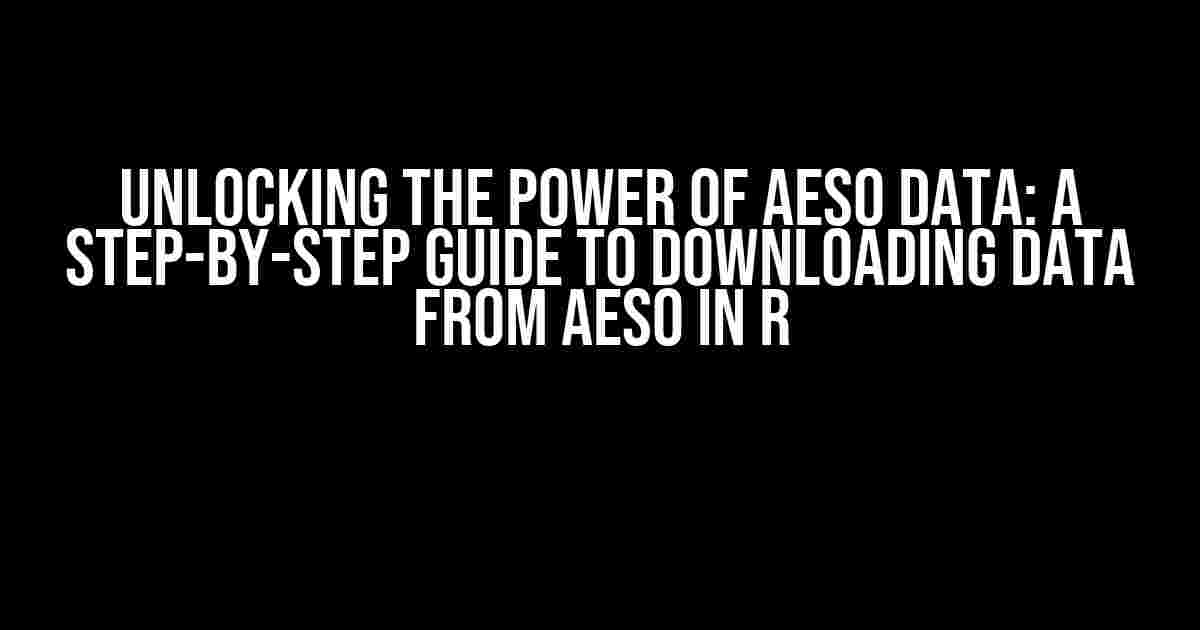Are you tired of scouring the web for reliable and up-to-date energy data? Look no further! The Alberta Electric System Operator (AESO) provides a treasure trove of electricity-related data, and with R, you can tap into this valuable resource like a pro. In this article, we’ll take you on a journey to download data from AESO using R, and unlock the secrets of the electric grid.
What is AESO and Why Should I Care?
The Alberta Electric System Operator (AESO) is the independent system operator responsible for ensuring the reliable operation of the Alberta electric grid. As part of their mandate, AESO collects and publishes a vast array of data related to electricity generation, transmission, and consumption. This data is a goldmine for anyone interested in energy analysis, forecasting, or research.
Why Download Data from AESO in R?
- AESO provides a wealth of data on electricity generation, transmission, and consumption, making it an invaluable resource for energy-related research and analysis.
- R is an ideal platform for data manipulation, analysis, and visualization, making it the perfect tool for unlocking the insights hidden within AESO data.
- By downloading data from AESO in R, you can automate the data retrieval process, saving time and effort, and focus on what matters most – extracting valuable insights from the data.
Prerequisites
- A working installation of R (download and install the latest version from the official R website)
- A basic understanding of R programming (don’t worry, we’ll cover the essentials)
- Internet connectivity (you’ll need it to download the data)
Step 1: Register for an AESO Account
The first step in downloading data from AESO is to register for an account on the AESO website.
- Head over to the AESO website ([www.aeso.ca](http://www.aeso.ca)) and click on the “Data” tab.
- Click on “Create an Account” and fill out the registration form.
- Verify your email address by clicking on the confirmation link sent by AESO.
Once you’ve registered and verified your account, you’ll be able to access the AESO data portal.
Step 2: Explore the AESO Data Portal
The AESO data portal is a treasure trove of electricity-related data, with datasets ranging from real-time system conditions to historical demand and supply data.
Take some time to explore the data portal, and familiarize yourself with the different datasets and data formats available.
Step 3: Choose Your Data
For this example, we’ll focus on downloading the 5-Minute Solar Radiation Data. This dataset provides solar radiation data in 5-minute increments for various locations across Alberta.
To choose your data, follow these steps:
- In the AESO data portal, click on the “Data” tab.
- Click on “Historical Data” and then select “Solar Radiation” from the dropdown menu.
- Choose the desired location and time period for your data.
- Click on the “Download” button to retrieve the data.
Step 4: Download Data using R
Now that we’ve chosen our data, it’s time to download it using R. We’ll use the `httr` package to send a GET request to the AESO API and retrieve the data.
# Install and load the httr package
install.packages("httr")
library(httr)
# Set the API endpoint and parameters
url <- "https://api.aeso.ca/api/v2/historical-data/solar-radiation"
params <- list(
location = "CALGARY",
start_date = "2020-01-01",
end_date = "2020-01-31",
frequency = "5MIN"
)
# Set the API key (replace with your own API key)
api_key <- "YOUR_API_KEY"
# Construct the API request
req <- GET(url, query = params, add_headers("Authorization" = paste("Bearer", api_key)))
# Check if the request was successful
if (status_code(req) == 200) {
# Parse the JSON response
data <- jsonlite::fromJSON(rawToChar(req$content))
# Convert the data to a data frame
df <- as.data.frame(data)
# Print the first few rows of the data
print(head(df))
} else {
# Handle API errors
print("Error:", status_code(req), ":", http_status(req))
}
Step 5: Explore and Analyze Your Data
Congratulations! You've successfully downloaded data from AESO using R. Now it's time to explore and analyze your data.
Use R's built-in data manipulation and visualization tools to uncover insights from your data. For example, you could use `ggplot2` to create a time series plot of the solar radiation data:
library(ggplot2) ggplot(df, aes(x = datetime, y = solar_radiation)) + geom_line() + theme_bw() + labs(title = "Solar Radiation Data", x = "DateTime", y = "Solar Radiation (W/m^2)")
Troubleshooting and Best Practices
When working with AESO data and R, you may encounter errors or issues. Here are some troubleshooting tips and best practices to keep in mind:
| Error/Issue | Solution/BP |
|---|---|
| API key errors | Double-check your API key and ensure it's valid and properly formatted. |
| Data format issues | Verify the data format and structure to ensure it matches your expectations. |
| Data limitations | Familiarize yourself with AESO's data limitations and usage guidelines to avoid errors. |
| Performance issues | Use efficient data manipulation and storage techniques to minimize performance issues. |
Conclusion
In this article, we've covered the steps to download data from AESO using R. By following these instructions, you'll be well on your way to unlocking the insights hidden within AESO data. Remember to explore the AESO data portal, choose the right data for your needs, and troubleshoot any issues that arise.
Happy data analyzing!
Note: This article is for educational purposes only and does not guarantee the accuracy or availability of AESO data. Please ensure you comply with AESO's terms of use and data usage guidelines when working with their data.
Frequently Asked Question
AESO (Alberta Electric System Operator) provides a wealth of data for energy enthusiasts and data analysts. However, downloading data from AESO in R can be a daunting task for beginners. Fear not, dear R users, for we've got you covered! Here are some frequently asked questions and answers to help you navigate the world of AESO data in R:
Q1: What is the best way to download AESO data in R?
The best way to download AESO data in R is by using the `aesodata` package. This package provides an easy-to-use interface to access and download AESO data, including historical data, forecast data, and more. Simply install the package, load the library, and use the `aesodata_download()` function to fetch the data you need.
Q2: How do I authenticate with AESO's API in R?
To authenticate with AESO's API in R, you'll need to register for an API key on the AESO website. Once you have your API key, you can use the `aesodata_api_key()` function from the `aesodata` package to set your API key. This will allow you to access AESO's API and download data using the `aesodata_download()` function.
Q3: What types of data are available for download from AESO?
AESO provides a wide range of data for download, including historical data, forecast data, and real-time data. You can access data on topics such as electricity demand, generation, transmission, and weather. The `aesodata` package provides an easy way to browse and download these datasets using R.
Q4: Can I download AESO data in bulk using R?
Yes, you can download AESO data in bulk using R! The `aesodata` package provides a `aesodata_download_bulk()` function that allows you to download large datasets in a single call. This function is particularly useful for downloading historical data or large datasets.
Q5: Are there any limits to the amount of data I can download from AESO using R?
Yes, there are limits to the amount of data you can download from AESO using R. AESO imposes limits on the number of API calls and the amount of data you can download per day. Be sure to check the AESO API documentation for the most up-to-date information on these limits. Additionally, the `aesodata` package provides built-in functionality to handle these limits and ensure that you don't exceed them.


